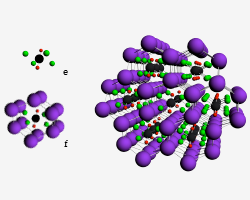
CAAR Oak Ridge Proposal for getting the Relativistic Quantum Chemistry Program Package DIRAC ready for SUMMIT
- Code: DIRAC
- Science Domain: Relativistic Quantum Chemistry
- PI: Lucas Visscher, Amsterdam Center for Multiscale Modeling /VU University Amsterdam
Description
Lucas Visscher and his colleagues are developing predictive modeling tools for future studies of new materials containing heavy elements and their reactive properties. Such simulations are important in finding safer methods for handling nuclear materials during the electricity generation phase, as well as improving their storage or possibly recycling them after usage in power plants. Summit’s GPU accelerators will enable DIRAC—the team’s relativistic quantum chemical application—to increase it’s current capability from modeling small systems with tens of atoms at most, to modeling systems with hundreds of atoms. This performance increase will enable a first-principles approach to investigating the electronic properties and molecular reactivity of uranium, platinum, gold and other important heavy metals. With that capability DIRAC can become a software tool sharable with the scientific community to test new methods, with the ultimate aims of limiting or even preventing the potentially harmful effects of handling radioactive material.
The Science
Heavy elements, such as uranium, plutonium and rare earth metals, possess a variety of unique properties that have been leveraged to create some of the most influential modern technologies—from nuclear energy to smartphones. Developing a predictive modeling tool based on first-principles physics could help scientists better understand heavy-element chemistry and lead to much-needed technologies, such as safer methods for storing and recycling nuclear waste.
Currently, the two main obstacles for developing such a robust model are the steep computational cost associated with calculation of electron-electron interactions and the necessity of tracking the motion of particles in relation to space and time.
Summit will largely lift these constraints, giving researchers the necessary computing power to track all heavy-element electrons and other notable system characteristics, including the relationship between a particle’s spin and its motion. With this newfound capability, scientists can expand their models from tens of atoms to hundreds of atoms, opening up unprecedented opportunities for studying heavy-element electronic structure and molecular properties.
The Team
Lucas Visscher of the Amsterdam Center for Multiscale Modeling and VU University Amsterdam heads a team of world-class leaders in theoretical chemistry and computational science. In partnership with the Oak Ridge Leadership Computing Facility (OLCF) and hardware vendors, Visscher’s team is advancing its quantum-chemical code, DIRAC, to leverage Summit’s large-node, GPU-accelerated architecture. OLCF experts have already been designing and implementing critical software modules that will allow DIRAC to leverage the massive parallelism possible on next-generation supercomputers.
DIRAC has been developed by a consortium of European research groups since the mid-90’s and has been adopted by a global community of users. The software is unique in its ability to account for the four-component nature of the Dirac equation, a relativistic wave equation that bridges both quantum mechanics and special relativity.
The Goal
By updating DIRAC to scale on Summit, Visscher’s team will be providing a software tool the scientific community can use to gain new insight into heavy element behavior and ever more subtle understanding of lighter elements. For heavily regulated, radioactive elements, this tool holds the promise of expanding research methods, with an ultimate aim of limiting radioactive material’s harmful effects, among other pursuits.


